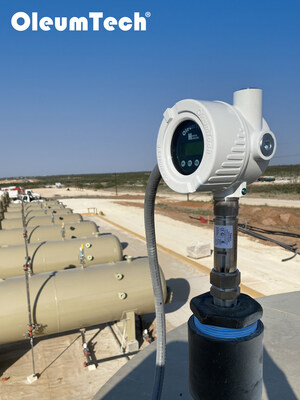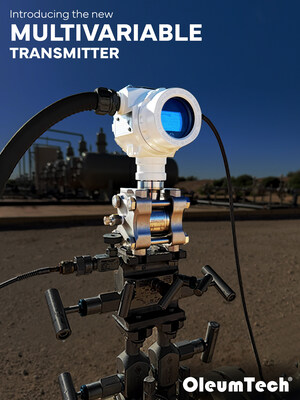OleumTech Wireless Sensor Networks are Enabling Oil & Gas Operators to Increase Efficiency and Reliability While Cutting Costs
FOOTHILL RANCH, Calif., Sept. 1, 2016 /PRNewswire/ -- As Machine to Machine (M2M), Internet of Things (IoT), and the Industrial Internet of Things (IIoT) continue to make the transition from technology magazines to corporate strategic initiatives, companies are recognizing a significant opportunity to enhance productivity, efficiency, and profitability through Wireless Sensor Networks, according to OleumTech® Corporation, a global leader in M2M communications and industrial automation solutions.
This press release is based on a white paper published by Mr. McAdams in 2016, and available in its entirety at http://goo.gl/xLpKzr.
Wireless Sensor Networks (WSNs) have emerged as a key technology for oil and gas exploration and production companies looking to gain a competitive advantage. Since initially introducing WSNs, manufacturers like OleumTech have enhanced product offerings to operate in the most inhospitable of environments while fortifying the technology with more robust communications architectures, hardening security, increasing reliability, and driving down power consumption. Through the entire oil and gas value chain (upstream, midstream, and downstream) as well as other industrial markets including electric power, water/waste water, and manufacturing, wireless sensor networks are increasingly being deployed where hardwiring was the de facto standard.
"For many industrial applications, it has been well documented that wirelessly connected assets are up to 10 times less expensive than wired alternatives," said Brent E. McAdams, Vice President, OEM & Strategic Initiatives at OleumTech. "Driven by substantial and measurable cost savings in engineering, installation, and logistics as well as dramatic improvements in the frequency and reliability of data, wireless sensor networks offer much faster startups, and accelerated profits."
A wireless sensor network can be defined as a network of end nodes communicating information gathered from sensor locations through wireless links. Depending on the communications architecture, the data is either forwarded directly to a gateway or through multiple end nodes back to a gateway. The gateway is then connected to other devices or networks such as a wired or wireless Ethernet backbone to relay sensor information to a control system.
These networks are used to monitor a variety of conditions, covering all process control variables regardless of vertical market, including but not limited to pressure, flow, temperature and level.
APPLICATIONS
The oil and gas industry is one of the most active industries for the application of wireless sensor networks, usually located in remote areas with rough terrain, elevation challenges, and extreme ambient environmental demands. Wireless sensor networks are deployed to monitor, manage and control everything from tanks and compressors to generators, separators and wellheads.
As operating costs have continued to rise while the price of oil experiences eight-year lows, wireless sensor networks offer advantages over the traditional wired technology where wired options are either too expensive or not even an option.
Wireless technology continues to make advances in terms of applications, thus, eliminating the need for cables, allowing for cost efficient network deployments. Wireless sensor networks may consist of many different types of sensors, covering a wide variety of applications consisting of pressure, temperature, flow, level or simply relaying a contact closure through a discrete transmitter.
Wireless sensor network applications most commonly cover monitoring of near real-time process control, safety, regulatory, and production performance.
POWERING WIRELESS SENSOR NETWORKS
"Energy harvesting" in the field is a key factor in wireless sensor network design simply because replacing batteries is not feasible; changing batteries for thousands of remotely deployed wireless sensor nodes could become an expensive logistical headache.
A variety of energy sources can be utilized to power wireless sensor end nodes. Solar, mechanical, and thermal energy are the primary sources. Given these options, harnessing solar power is the most used and mature energy harvesting technique. Power consumption is driven by the frequency of transmissions. For certain condition monitoring applications such as monitoring tank level, latency in duty cycle is less important. However, reliability remains vital.
BOTTOM LINE: DATA IS KEY
"Driven by the growing demand for advanced technology solutions to enhance productivity, efficiency, and profitability, all industrial sectors are harnessing the power of wireless sensor networks," McAdams said. "Innovation is driven by data that enables operators to improve processes, reduce costs, enhance efficiency, make better decisions, and understand their customers' unique requirements."
ABOUT OleumTech
OleumTech Corporation is a leading manufacturer of industrial automation systems that represents the new paradigm of remote monitoring and control for industries such as Oil & Gas, Refining, Petro-Chemical, Utilities and Water/Wastewater. With over 300,000 nodes deployed, the patented system eliminates costs associated with running cables and digging trenches with the use of its wireless tank monitoring, wellhead monitoring and peer-to-peer oilfield process automation solutions. Forming the foundation of a highly scalable, peer-to-peer wireless infrastructure, the OleumTech Wireless Systems enables "last mile" connectivity in any wireless SCADA and telemetry application.
For more information on OleumTech, or to set up an interview with Mr. McAdams, please contact Dan Chmielewski.
CONTACT INFORMATION
Dan Chmielewski
Madison Alexander PR
(714) 832-8716
[email protected]
Photo - http://photos.prnewswire.com/prnh/20160829/402350
SOURCE OleumTech
WANT YOUR COMPANY'S NEWS FEATURED ON PRNEWSWIRE.COM?
Newsrooms &
Influencers
Digital Media
Outlets
Journalists
Opted In




Share this article